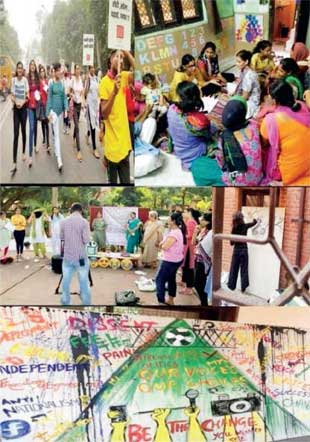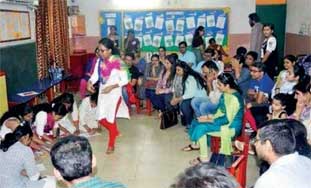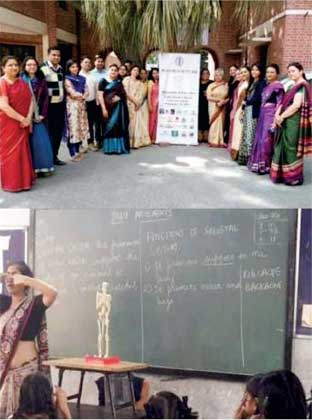Sarita Anand and Sunaina Batra
Home science is known by some other popular names such as community and family sciences or human ecology. It is taught at the college and university level across the country. At the school level it is offered from class 6 to 10 and then at the senior secondary level, when students choose a stream. It is offered as a core course within both streams of science and humanities as per CBSE. The curricula at senior secondary level – that is classes 11 and 12 expose students to the five sub-disciplines of home science. These are food and nutrition, child development, and human development and family studies, resource management, clothing and textiles and development communication and extension. The class 11 and 12 NCERT textbooks include chapters with details on specializations along with career prospects of all the five major areas. The course content motivates and inspires students to pursue home science as a career option. A majority of the students pursue a professional degree with B.Sc, M.Sc and Ph.D degrees in home science from various government or private colleges and agricultural and traditional universities.
It is important that students are aware of the skill sets required before they choose home science as a preferred option to pursue higher education. Teachers are the best enablers in helping students identify their strengths and aptitude. Teachers are also a good resource to connect them with professional education in home science at college and university levels based on their own in-depth information about the recent shifts in curricula and the emerging career opportunities for students related to various specializations.

We will be discussing in detail about the sub-field of Development Communication & Extension (DCE), which has played a key role in achieving development goals of the country related to management of development programmes, campaigns, and interventions dealing with nutrition, health, education, women empowerment, crafts and handicrafts promotion and environment conservation.
This discipline has evolved over time and continues to respond to the emerging development needs of the country. It has its roots in the philosophy of enabling and facilitating social change. It aims at synergistic use of mass media and interpersonal communication to effectively communicate issues related to development. The aim is to extend or reach out to the unreached with skillful communication processes and techniques. With foundations of basic elements in communication, empathy, persuasion, perception and methods of outreach, the sub-field of DCE has come to be a preferred choice. It offers a comprehensive curriculum structure at the undergraduate level along with a specialized and advanced curriculum at the postgraduate level. It covers the domains of development, communication and extension. These need to be introduced with concrete examples of career avenues and the required specialized skill sets.
This article also focuses on how curriculum can be effectively transacted by the teachers.

Reconstructing classroom teaching: What can teachers do?
Teachers can play an important role in making students realize the value of home science. Teachers can be proactive in exposing students to all the dimensions of this professional course by connecting them with illustrious alumni of home science. They can also conduct virtual tours of the good institutes offering home science in the country, talk to their students about the latest developments in curriculum, research, innovations and collaborative projects with national and international agencies.
We shall now discuss how simple and complex topics pertaining to this field can be taught in an interesting manner. We shall explore each of the domains here of development, communication, journalism and extension and give teachers insights into effective and interesting ways with the help of examples.
Let’s learn with examples
Development: The construct of development is vast and abstract for many to understand. It becomes tricky for teachers to comprehensively explain to the students about what development entails. We may go the rhetoric way. However, a unique approach here can be to ask students to draw and envision an ‘India of my dreams’. A mind map would work here and eventually students would end up listing issues that are related to development. This activity can make students think differently and futuristically. It can be a great starting point for the teacher to throw light on the multi-dimensional nature of development.
Communication: What if we need students to understand the barriers in communication? The tried and tested method is a theoretical explanation about various barriers. However, a smart teacher can bring novelty in her classroom by starting a game of ‘Chinese Whispers’ and then discussing what led to the misinterpreted form of the original message. This activity can explicitly highlight what barriers are and how they harm the process of communication.

Journalism: Now, let us take a classroom scenario, where a teacher wishes to talk about development reporting or journalism. One way is she explains all the concepts and takes the students’ feedback. The second and more effective way is to actually ask students to bring newspapers to class and ask them to identify articles that report about development. The latter will give students a first-hand experience of delving into the issue and understanding it better, not only from the problem perspective but also how the reporter made the story worth reading, what draws attention, how facts are placed to generate interest,the role of the administration, governance and legal views around the issue, etc.
Extension: The concept of extension will be best understood by the students when they themselves experience it. Principles of ‘experiential learning’ or ‘learning by doing’ is the key here. Let students voluntarily try to reach out to someone who is vulnerable or unreached. It could be their maid’s children, driver’s children or any labourers they have access to. When they try and provide literacy skills to these client groups, they will understand the process and ethos of extension. Teachers can encourage such outreach activities. At the school level too, melas or field visits can be organized by teachers to provide an opportunity to students to understand extension.
Given the diverse curriculum, teachers need to adopt skill based and innovative methodologies to transact the same. Teachers themselves need to harness their teaching skills and adopt both standardized and contemporary methods of teaching. Some of the innovations that can be employed by teachers are:

Field visits
A most effective way to learn extension is to experience it. Field visits to communities and NGOs are a great way to learn about the socio-cultural and economic environments that exist and also provide insight into the community dynamics.
Use of audio-visual aids
Teachers can used different audio-visual aids such as films, podcasts, videos,etc., to enrich classroom teaching. Other than using powerpoint, bulletin boards and charts, teachers can innovate and co-create interesting AV aids with students.
Use of technology
Technology is today interspersed in every discipline. The year 2020-21 especially shifted teaching to online platforms. Being abreast with various classroom teaching platforms has become a must in today’s times. Within online teaching too teachers can use innovative software to make the class more interactive.
Internships
Along with class teaching, internships with NGOs, media houses, UN organizations and corporates enable students to get hands-on experience and an orientation to the world of work and expected professional ethics.

Career scope
Career options for home scientists who specialize in this field are ample and fulfilling with arenas extending to government, non-government and private sectors. Today, dedicated job portals exist for development professionals and graduates. Teachers must themselves gain clarity on what options exist and try and disseminate the same in the classroom. Here are some specific popular domains where development communication and extension graduates can score well:
• Teaching at all levels, from school, college and university to teacher training institutes after completing master’s degree followed by a degree in Education and qualifying appropriate eligibility exams.
• Research with government ministries, research agencies and autonomous organizations.
• Programme managers and coordinators to plan, implement, monitor and evaluate government and non- government interventions for health, education, nutrition, women development and advocacy initiatives.
Training and capacity building, Corporate Social Responsibility, advertising and public relations, content creation for online public engagement by development and corporate organizations, management of social media for organizations, knowledge management for research and advocacy organizations, community media like community radio and participatory video initiatives and extension officers for various central and state government programmes are some of the other avenues where students can find fulfilling careers. The students may begin their career as researchers or assistants and gradually rise to take up the topmost positions in national and international organizations with time and experience.
Listed below are some links that can come in handy for all the aspirants:
Curriculum DCE: http://www.ladyirwin.edu.in/dce.aspx
Job Portal: https://www.devnetjobsindia.org/
https://indevjobs.org/
Other references related to career scope:
http://employmentnews.gov.in/careeredu.pdf
http://employmentnews.gov.in/Career-in-development-Communication.asp
Sarita Anand is Associate Professor, Department of Development Communication and Extension, Lady Irwin College, University of Delhi. She can be reached at sarita.anand@lic.du.ac.in.
Sunaina Batra is Assistant Professor, Department of Development Communication and Extension, Lady Irwin College, University of Delhi. She can be reached at sunaina.batra@lic.du.ac.in.
